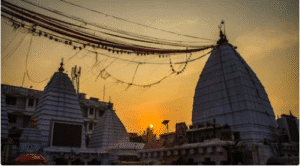 Every monsoon season, the landscape of northern India transforms into a river of saffron. Thousands of devotees, draped in orange, walk miles chanting “Bol Bum! Har Har Mahadev!” as they journey to pour sacred river water on the Lord Shiva lingam.
Every monsoon season, the landscape of northern India transforms into a river of saffron. Thousands of devotees, draped in orange, walk miles chanting “Bol Bum! Har Har Mahadev!” as they journey to pour sacred river water on the Lord Shiva lingam.
The Bol Bum Yatra, a hallmark of Hindu devotion, peaks during the Shravan month, bringing together stories of mythology, self-discipline, and cultural unity. From the legend of Ravan Kund to the spiritual power of Nagvasuki Temple, this journey is more than physical—it’s a passage through time, faith, and the soul.
Why Sawan is Sacred for Lord Shiva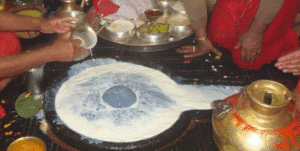
The Legend of Neelkanth
According to Hindu scriptures, the month of Shravan is when the Samudra Manthan—the cosmic churning of the ocean—took place. During this celestial event, a deadly poison known as Halahala emerged.
To protect the universe, Lord Shiva drank the poison, which lodged in his throat, turning it blue. Since then, he is revered as Neelkanth, the blue-throated one. This act of selfless sacrifice is believed to have occurred in the month of Sawan.
Devotees offer cool water and bael leaves on Shiva lingas to soothe his pain—acts of symbolic gratitude that echo across centuries.
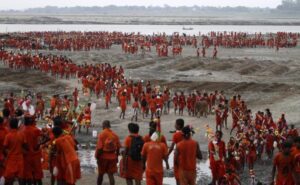 What is the Bol Bum Yatra?
What is the Bol Bum Yatra?
The phrase “Bol Bum” is more than a chant—it’s a call to awaken devotion. Pilgrims, known as Kanwariyas, collect sacred water from rivers like the Ganga—especially from Sultanganj—and carry it to Shiva temples such as Baidyanath Dham in Deoghar, often walking barefoot across vast distances.
They carry their water in Kanwars—decorated bamboo carriers—and many observe strict fasts during this time. The journey can stretch for days, but the spirit never fades. Chanting “Har Har Mahadev” along the way, they energize both body and soul.
The Bol Bum pilgrimage is especially popular in Bihar, Jharkhand, Uttar Pradesh, and Odisha, though its influence now spans across India and Nepal.
Ravan Kund and the Mythical Origin of the Yatra
A Demon’s Devotion
While Ravan is often depicted as the antagonist of the Ramayan, in Shaivism, he is remembered as a fierce devotee of Lord Shiva. According to legend, Ravana would bathe in a sacred pond—now known as Ravan Kund—before offering Ganga water to the Baidyanath Jyotirlinga in Deoghar.
To this day, Ravan Kund is a revered stop for Kanwariyas. Many pause to offer prayers or take a symbolic dip before continuing their journey. The pond represents Ravana’s humility and unwavering devotion, offering a reminder that even flawed souls can seek divine grace through bhakti.
 The Sacred Stops: Baidyanath Dham, Nagvasuki Temple & the 4 Dham Connection
The Sacred Stops: Baidyanath Dham, Nagvasuki Temple & the 4 Dham Connection
Baidyanath Dham – The Heart of the Yatra
Located in Deoghar, Jharkhand, Baidyanath Dham is one of the twelve Jyotirlingas. It is considered the primary destination for Bol Bum devotees. Pilgrims believe that pouring Ganga water here during Sawan brings blessings, healing, and spiritual merit.
Nagvasuki Temple – The Forgotten Power Center
Tucked away near the Ganga, the Nagvasuki Temple in Prayagraj is dedicated to Lord Shiva and the serpent deities (Nāgas). Shiva is often depicted with a snake coiled around his neck, symbolizing mastery over primal energy.
During Shravan, this temple becomes a hub of spiritual power. Devotees offer milk and water not just to Shiva but also to the serpent idols, seeking protection from fear, evil, and inner negativity. This temple is often considered a hidden gem in the alternative Chota Char Dham circuit of northern India.
The Spiritual 4 Dham Pilgrimage
Beyond the classical Char Dham, Sawan devotees often map a spiritual route connecting Sultanganj, Ravan Kund, Nagvasuki Temple, and Baidyanath Dham. Each stop holds unique energy—purification, sacrifice, healing, and liberation.
The Devotion and Discipline Behind the Yatra
Pilgrims wear orange or saffron, symbolizing renunciation and purity. Many refrain from consuming grains, sleep on floors, avoid physical indulgence, and maintain silence for portions of the journey. Barefoot walking becomes more than penance—it becomes prayer in motion.
The Shravan Somvar fasts, observed every Monday during Sawan, are another key ritual. Devotees eat only once a day, chant Shiva mantras, and visit temples. Each fast is a vow, a personal promise to honor the divine with patience and faith.
The Cultural Impact of the Kanwar Yatra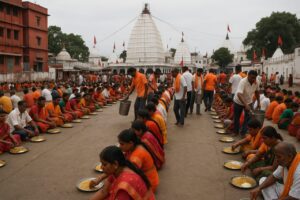
Across states, the Yatra becomes a moving festival. Temporary rest camps, called Kanwar Shivirs, pop up along the roads. These are filled with bhajans, free meals (langars), first-aid services, and spiritual talks.
Volunteers from villages and cities contribute—setting up water booths, helping injured pilgrims, and feeding thousands daily. The Bol Bum Yatra becomes a symbol of seva (selfless service) and sangha (community).
It’s one of the rare cultural moments where caste, class, and background dissolve in shared chants of “Har Har Mahadev.”
A Sacred Shloka to Honor Mahadev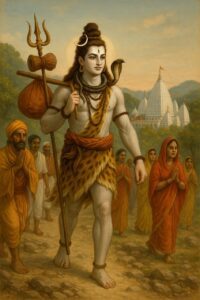
जय शिव शंकर भोलेनाथ, त्रिपुरारी नमोऽस्तु ते।
गंगाधर नीलकण्ठाय, नमः शम्भो महेश्वर॥
Translation:
Victory to Shiva, the compassionate one.
Salutations to the bearer of the Ganga and the blue-throated Maheshwara.
This shloka is often recited during the Yatra, especially when offering water on the Shivling. It’s a prayer of healing and surrender.
A Personal Reflection
Many who’ve taken this journey report life-changing insights. One devotee from Patna shared, “I walked 105 km to Deoghar in the rain, chanting Bol Bum. By the end, I wasn’t tired—I was transformed. It felt like I’d walked back into my true self.”
The Yatra isn’t just an external act—it’s a return to your inner sanctum, beyond distraction, noise, and ego.
Final Thoughts: Walking with Faith
The Bol Bum Yatra during Shravan month is more than a pilgrimage—it’s a living embodiment of Hindu dharma: devotion, discipline, simplicity, and surrender. From the mystical energy of Ravan Kund, the snake-wrapped symbolism of Nagvasuki Temple, to the divine pull of Baidyanath Dham, the journey is layered with myth, meaning, and personal transformation.
As lakhs of voices echo “Bol Bum” through the roads of India, they’re not just chanting. They’re awakening their souls.
📩 Call to Action:
Have you taken part in the Kanwar Yatra or visited Baidyanath Dham or Ravan Kund? Share your story in the comments!
Want more spiritual insights like this? Subscribe to our newsletter for new articles every week.

